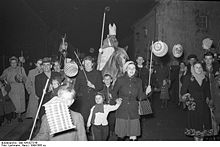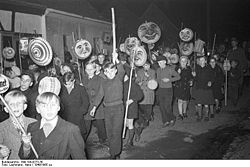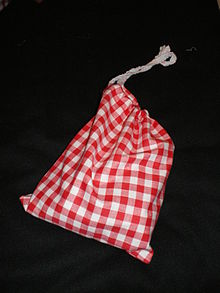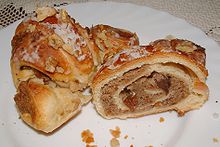- St. Martin's Day
-
St. Martin's Day, also known as the Feast of St. Martin, Martinstag or Martinmas, the Feast of St Martin of Tours or Martin le Miséricordieux, is a time for feasting celebrations. This is the time when autumn wheat seeding is completed. Historically, hiring fairs were held where farm laborers would seek new posts. The feast day is November 11, the feast day of St. Martin of Tours, who started out as a Roman soldier. He was baptized as an adult and became a monk. It is understood that he was a kind man who led a quiet and simple life. The most famous legend of his life is that he once cut his cloak in half to share with a beggar during a snowstorm, to save the beggar from dying of the cold. That night he dreamed that Jesus was wearing the half-cloak Martin had given away. Martin heard Jesus say to the angels: "Here is Martin, the Roman soldier who is not baptised; he has clothed me." [1]
Contents
Customs
From the late 4th century to the late Middle Ages, much of Western Europe, including Great Britain, engaged in a period of fasting beginning on the day after St. Martin's Day, November 11. This fast period lasted 40 days, and was, therefore, called "Quadragesima Sancti Martini", which means in Latin "the forty days of St. Martin." At St. Martin's eve, people ate and drank very heartily for a last time before they started to fast. This period of fasting was later shortened and called "Advent" by the Church.
In Ireland, on the eve of St. Martin's Day, it is tradition to sacrifice a cockerel by bleeding it. When the blood was collected, it was sprinkled on four corners of the house. Also in Ireland, no wheel of any kind was to turn on St. Martin's Day because Martin was thrown into a mill stream and killed by the wheel and because of that, it was not right to turn any kind of wheel on that day.
In some parts of the Germany, Netherlands and Belgium, children make their own lantern and go door to door with the lantern, and sing St. Martin songs, in exchange for sweets.
Many churches in Europe are named after Saint Martinus. St. Martin is the patron saint of Szombathely in Hungary, with a church dedicated to him, and also the patron saint of Quillota in Chile and Buenos Aires.
In Latin America, Martin has a strong popular following and is frequently referred to as San Martín Caballero, in reference to his common depiction on horseback.
Though no mention of Saint Martin's connection with viticulture is made by Gregory of Tours or other early hagiographers, he is nonetheless credited with a prominent role in spreading wine-making throughout the Touraine region and facilitating the planting of many vines. The Greek myth that Aristaeus first discovered the concept of pruning the vines after watching a goat eat some of the foliage has been appropriated to Martin.[2] Martin is also credited with introducing the Chenin Blanc grape varietal, from which most of the white wine of western Touraine and Anjou is made.
Martin Luther was named after Saint Martin, as he was baptized on November 11 (St. Martin's Day), 1483.
Historical meaning of Martinmas
The feast coincides not only with the end of the Octave of All Souls, but with harvest-time, the time when newly-produced wine is ready for drinking, and the end of winter preparations, including the butchering of animals. (An old English saying is "His Martinmas will come as it does to every hog," meaning "he will get his comeuppance" or "everyone must die".) Because of this, St. Martin's Feast is much like the American Thanksgiving (celebrated on the 4th Thursday in November) -- a celebration of the earth's bounty. Because it also comes before the penitential season of Advent, it is seen as a mini "carnivale", with all the feasting and bonfires. As at Michaelmas on 29 September, goose is eaten in most places (the goose is a symbol for St. Martin himself. It is said that as he was hiding from the people who wanted to make him Bishop, a honking goose gave away his hiding spot).
In many countries, including Germany, Martinmas celebrations begin at the eleventh minute of the eleventh hour of this eleventh day of the eleventh month. Bonfires are built, and children carry lanterns in the streets after dark, singing songs for which they are rewarded with candy.
Originating in France, the tradition of celebrating Martinmas spread to Germany in the 16th century and later to Scandinavia and the Baltics. In Estonia, Martinmas signifies the merging of Western European customs with the local Balto-Finnic pagan traditions, it also contains elements of earlier worship of the dead as well as certain year-end celebration that predates Christianity.
Martinmas actually has two meanings: in the agricultural calendar it marks the beginning of the natural winter, but in the economic calendar it is seen as the end of autumn.
Among Estonians, Martinmas also marks the end of the period of All Souls, as well as the autumn period in the Estonian popular calendar when the souls of ancestors were worshiped, a period that lasted from November 1 to Martinmas (November 11).
Like Michaelmas (St. Michael's Day), celebrated on September 29, Martinmas is also known as the celebration that marks the end of field work and the beginning of the harvesting period. Following these holidays, women traditionally moved their work indoors for the winter, while men would proceed to work in the forests.
Celebrations around the world
Austria, Belgium, Germany and Netherlands
 Children going door to door with paper lanterns on St. Martin's Day in the Netherlands
Children going door to door with paper lanterns on St. Martin's Day in the Netherlands
The day is celebrated on the evening of November 11 in some parts of the Netherlands, in a small part of Belgium (mainly in the east of Flanders and around Ypres), and in most areas of Germany and Austria. Children go through the streets with paper lanterns and candles, and sing songs about Saint Martin. Sometimes, a man dressed as Saint Martin rides on a horse in front of the procession.
Over time the lantern processions have become widespread even in Protestant areas of Germany (Martinisingen on 10 November) and the Netherlands, despite the fact that most Protestant churches do not recognize saints.
 St. Martin character in a procession in West Germany
St. Martin character in a procession in West Germany
Also, in the east part of the Belgian province of West Flanders, especially around Ypres, children receive presents from either their friends or family as supposedly coming from Saint Martin on November 11. In other areas it is customary that children receive gifts later in the year from either their friends or family as supposedly coming from Saint Nicholas on December 5 (called Sinterklaas in the Netherlands) or Santa Claus on December 25.
In some areas, there is a traditional goose meal, although in West Flanders there is no specific meal; it is more a day for children, with toys brought on the night of 10 to 11 November. According to legend, Martin was reluctant to become bishop, which is why he hid in a stable filled with geese. The noise made by the geese betrayed his location to the people who were looking for him.
In some regions of Germany, the traditional sweet of Martinmas is "Martinshörnchen", a pastry shaped in the form of a croissant, which recalls both the hooves of St. Martin's horse and, by being the half of a pretzel, the parting of his mantle. In parts of western Germany these pastries are shaped like gingerbread men. Another widespread custom in Germany is bonfires on St. Martin's eve, called "Martinsfeuer." In recent years, the processions that accompany those fires have been spread over almost a fortnight before Martinmas, but previously, the Rhine River valley, for example, would be literally lined with fires on the eve of Martinamas.
In Berlin, on Martinmas it is customary to cook and eat a "Martin Goose" or "Martinsgans", which is usually served in restaurants roasted along with red cabbage and dumplings.
Croatia, Slovenia
In Slovenia and Croatia, St. Martin's Day (Martinje) marks the day when the must traditionally turns to wine. The must is usually considered impure and sinful, until it is baptised and turned into wine. The baptism is performed by someone who dresses up as a bishop and blesses the wine, this is usually done by the host. Another person is chosen as the godfather of the wine. The foods traditionally eaten on the day are goose and almost always home-made or store bought mlinci.
Slovakia
In Slovakia, the Feast of St. Martin is like a "2nd Birthday" for those named after this saint. Small presents or money are common gifts for this special occasion. Tradition says that if it snows on the feast of St. Martin, November 11th, then St. Martin came on a white horse and there will be snow on Christmas day. However, if it doesn't snow on this day, then St. Martin came on a dark horse and it will not snow on Christmas.
Czech Republic
A Czech proverb connected with the Feast of St. Martin - Martin přijíždí na bílém koni (trans. "Martin is riding in on a white horse") - signifies that the first half of November in the Czech Republic is the time when it often starts to snow. There used to be (and still is in some part of the country) a festival (posvícení) with a roast goose as a feast dish.[3]
Denmark
In Denmark, Mortensaften, meaning the night of St. Martin, is celebrated with traditional dinners, while the day itself is rarely recognized. (Morten is the Danish vernacular form of Martin). The background is the same legend as mentioned above, but nowadays the goose is most often replaced with a duck due to size, taste and/or cost.
Estonia
For centuries Mardipäev (Martinmas) has been one of the most important and cherished days in the Estonian folk calendar. It remains popular today, especially among young people and the rural population. Martinmas celebrates the end of the agrarian year and the beginning of the winter period. On this day children disguise themselves as men and go from door to door, singing songs and telling jokes to receive sweets.
Latvia
Mārtiņi (Martin's) is traditionally celebrated by Latvians on November 10, marking the end of the preparations for winter, such as salting meat and fish, storing the harvest and making preserves. Mārtiņi also marked the beginning of masquerading and sledding, among other winter activities.
Malta
St. Martin's Day (Jum San Martin in Maltese) is celebrated in Malta on the Sunday nearest to November 11. Children are given a bag full of fruits and sweets associated with the feast, known by the Maltese as Il-Borża ta' San Martin, "St Martin's bag". This bag would include walnuts, hazelnuts, almonds, chestnuts, dried or processed figs, seasonal fruit (like oranges, tangerines, apples and pomegranates) and "Saint Martin's bread roll" (Maltese: Ħobża ta' San Martin).
There is a traditional rhyme associated with this custom:
Ġewż, Lewż, Qastan, Tin
Kemm inħobbu lil San Martin.
(Walnuts, Almonds, Chestnuts, Figs
I love Saint Martin so much.)A feast is celebrated in the village of Baħrija on the outskirts of Rabat (Malta), including a procession led by the statue of Saint Martin. There is also a fair, and a show for local animals. San Anton School, a private school on the island, organises a walk to and from a cave especially associated with Martin in remembrance of the day.
A number of places in Malta are named after this saint, including San Martin on the outskirts of St. Paul's Bay, and Ġebel San Martin outside of Żejtun.
Poland
St. Martin's Day is celebrated in the Greater Poland region of Poland, mainly in its capital city Poznań. On this day, the people of Poznań buy and eat considerable amounts of "Rogale" ( pronounced Ro-galay) locally produced croissants, made specially for this occasion from half-French paste with white-poppy seeds, crushed almonds or walnuts and dainties, so-called "Rogal świętomarciński" or Martin Croissants or St. Martin Croissants. In recent years, competition amongst local bakeries has become fierce for producing the best "Rogale", and very often bakeries proudly display a certificate of compliance with authentic, traditional recipes. Poznanians celebrate with a feast, specially organised by the city. There are different concerts, a St. Martin's parade and a fireworks show.
-
-
- See : Rogal świętomarciński
-
Portugal
In Portugal, St. Martin's Day is commonly associated with the celebration of the maturation of the year's wine, being traditionally the first day when the new wine can be tasted. It is celebrated, traditionally around a bonfire, eating the magusto, chestnuts roasted under the embers of the bonfire (sometimes dry figs and walnuts), and drinking a local light alcoholic beverage called água-pé (literally "foot water", made by adding water to the pomace left after the juice is pressed out of the grapes for wine - traditionally by stomping on them in vats with bare feet, and letting it ferment for several days), or the stronger jeropiga (a sweet liquor obtained in a very similar fashion, with aguardente added to the water). Água-pé, though no longer available for sale in supermarkets and similar outlets (it is officially banned for sale in Portugal), is still generally available in small local shops from domestic production.
Leite de Vasconcelos regarded the magusto as the vestige of an ancient sacrifice to honor the dead and stated that it was tradition in Barqueiros to prepare, at midnight, a table with chestnuts for the deceased family members go and eat.[4] The people also mask their faces with the dark wood ashes from the bonfire. A typical Portuguese saying related to Saint Martin's Day:
É dia de São Martinho;
comem-se castanhas, prova-se o vinho.
(It is St. Martin's Day,
we'll eat chestnuts, we'll taste the wine.)This period is also quite popular because of the usual good weather period that occurs in Portugal in this time of year, called Verão de São Martinho (St. Martin's Summer). It is frequently tied with the legend since Portuguese versions of St. Martin's legend usually replace snowstorm with rain (because snow is extremely rare in most parts of Portugal, while rain is common at that time of the year) and have Jesus bringing the end of it, thus making the "summer" a gift from God.
Spain
In Spain, St. Martin's Day is the traditional day for slaughtering fattened pigs for the winter. This tradition has given way to the popular saying "A cada cerdo le llega su San Martín", which translates as "Every pig has its St. Martin's day" in English. The phrase is used to indicate that wrongdoers eventually get their comeuppance.
Switzerland
Its celebration has mainly remained a tradition in the Swiss Catholic region of the Ajoie in the canton of Jura. The traditional gargantuan feast, the Repas du Saint Martin, includes all the parts of freshly butchered pigs, accompanied by shots of Damassine, and lasting for over 5 hours at the least.
United Kingdom
In the United Kingdom, St Martin's Day is known as Martinmas (or sometimes Martlemass). It is one of the term days in Scotland.
Martlemass beef was beef from cattle slaughtered at Martinmas and salted or otherwise preserved for the winter. The now largely archaic term "Saint Martin's Summer" referred to the fact that in Britain people often believed there was a brief warm spell common around the time of St. Martin's Day, before the winter months began in earnest. The more common term in modern English is "Indian Summer".
In Northern Ireland the village and surrounding parish of Desertmartin owes its name to Saint Columba (also referred to as Colmcille) who visited there in the sixth century. He erected a church there as a retreat and named it in honour of Saint Martin. Hence the name in Irish Díseart Mhartain or 'Resting place of Martin'.
In the United Kingdom however, November 11 is now better known for being Remembrance Day.
Armistice Day
'Armistice Day' (also known as 'Remembrance Day' and 'Veterans Day') is on 11 November and commemorates the armistice signed between the Allies of World War I and Germany at Compiègne, France, for the cessation of hostilities on the Western Front, which took effect at eleven o'clock in the morning — the "eleventh hour of the eleventh day of the eleventh month" of 1918.
See also
References
- ^ Sulpicius, ch 2 CSBSJU.edu
- ^ For instance, in Hugh Johnson, Vintage: The Story of Wine 1989, p 97.
- ^ Brand's Popular Antiquities, London, 1849
- ^ Leite de Vasconcelos, Opúsculos Etnologia — volumes VII, Lisboa, Imprensa Nacional, 1938
External links
Categories:- Christian festivals and holy days
- November observances
- Saints days
- Holidays in Scotland
- Autumn holidays
- Scottish quarter days
-
Wikimedia Foundation. 2010.



